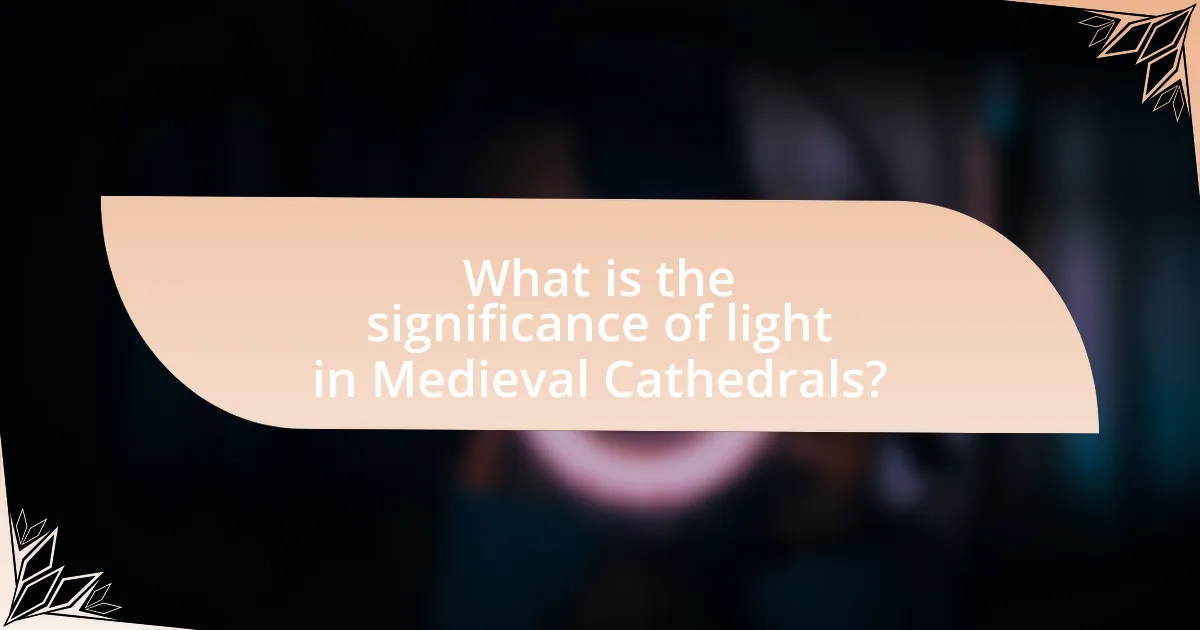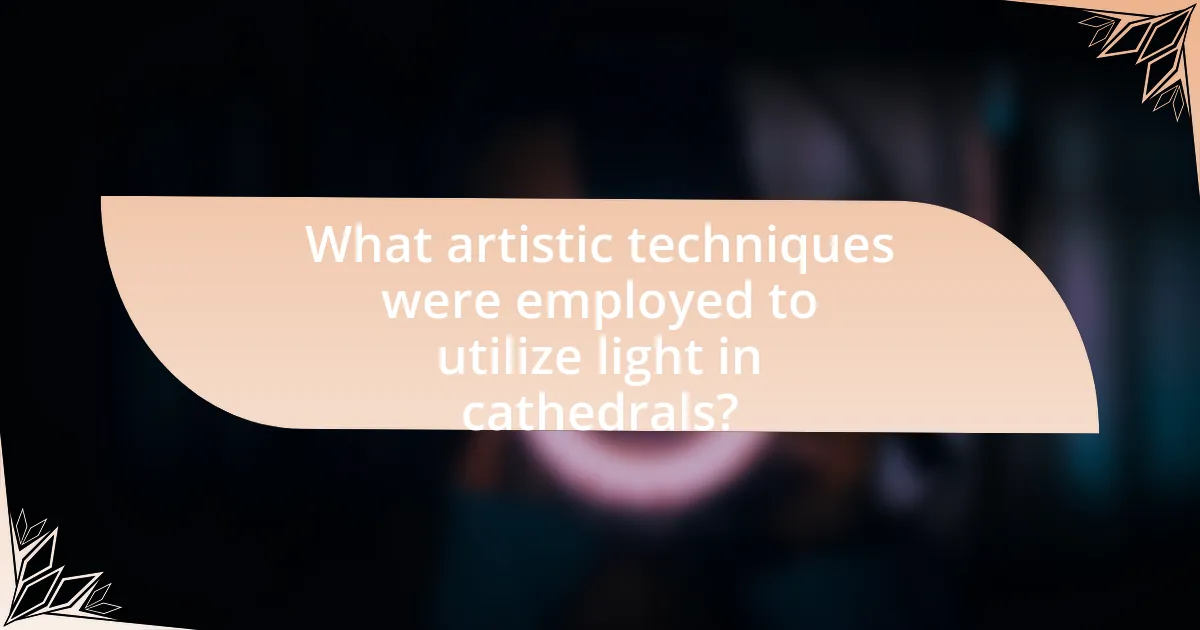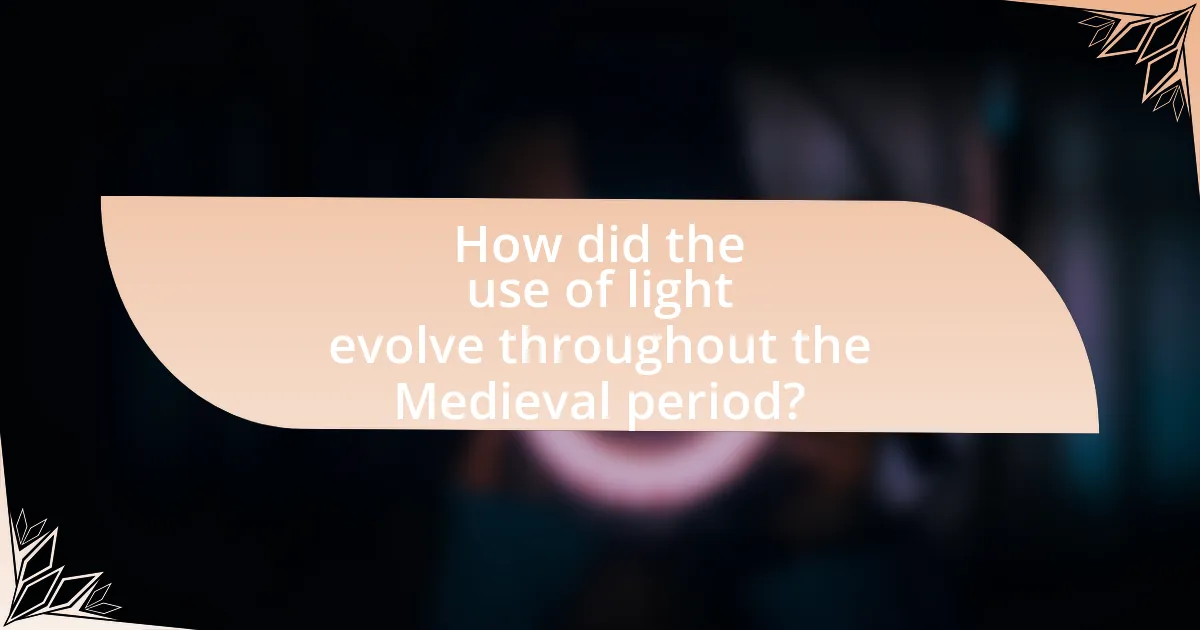The article analyzes the use of light in Medieval cathedrals, emphasizing its spiritual and artistic implications. It explores how light served as a symbol of divine presence and enlightenment, influencing architectural design through the strategic placement of stained glass windows and clerestory windows. Key topics include the manipulation of light through architectural elements, the theological concepts associated with light, and the evolution of lighting techniques from early to late Medieval periods. The article also discusses the lasting impacts of these practices on modern architecture and the lessons contemporary designers can learn from the historical use of light in sacred spaces.

What is the significance of light in Medieval Cathedrals?
The significance of light in Medieval Cathedrals lies in its role as a symbol of divine presence and spiritual enlightenment. Light was meticulously designed to filter through stained glass windows, creating a colorful illumination that transformed the interior space, enhancing the worship experience. This use of light not only served an aesthetic purpose but also conveyed theological messages, as seen in the way biblical stories were depicted in the glass, guiding the faithful in their understanding of scripture. Historical evidence shows that architects like Abbot Suger of Saint-Denis emphasized light as a means to connect the earthly realm with the divine, reflecting the belief that light represented the glory of God.
How did light influence the architectural design of cathedrals?
Light significantly influenced the architectural design of cathedrals by guiding the placement of windows and the overall structure to enhance spiritual experiences. Architects utilized large stained glass windows to allow natural light to flood the interiors, creating a divine atmosphere that symbolized the presence of God. For instance, the use of pointed arches and ribbed vaults in Gothic cathedrals enabled the construction of taller structures with expansive windows, as seen in Notre-Dame de Paris, completed in the 14th century. This design not only maximized light entry but also allowed for intricate biblical narratives depicted in the stained glass, reinforcing the spiritual message of the space.
What architectural elements were used to manipulate light?
Architectural elements used to manipulate light in medieval cathedrals include stained glass windows, clerestory windows, and ribbed vaults. Stained glass windows allowed for the diffusion of natural light while adding color and narrative to the interior, enhancing the spiritual experience. Clerestory windows, positioned high on the walls, maximized light entry and created a sense of elevation and transcendence. Ribbed vaults not only supported the structure but also directed light through the space, contributing to the overall illumination and atmosphere of the cathedral. These elements collectively transformed light into a medium of spiritual expression and artistic representation.
How did the orientation of cathedrals affect light entry?
The orientation of cathedrals significantly influenced light entry by aligning their main axes towards the east, allowing sunlight to illuminate the interior during morning services. This strategic positioning not only enhanced the spiritual experience by symbolizing the resurrection but also highlighted architectural features, such as stained glass windows, which were designed to capture and refract light. Historical examples, such as the Cathedral of Notre-Dame in Paris, demonstrate this practice, where the eastern orientation maximizes natural light during key liturgical moments, reinforcing the connection between divine light and sacred space.
Why was light considered a spiritual symbol in Medieval times?
Light was considered a spiritual symbol in Medieval times because it represented divine presence and enlightenment. In the context of Medieval cathedrals, light was often used to create an atmosphere that evoked the sacred, with stained glass windows filtering sunlight to produce colorful effects that symbolized the glory of God. This use of light was rooted in theological beliefs, where light was associated with purity, truth, and the divine nature of Christ, as articulated in biblical texts such as John 8:12, where Jesus declares, “I am the light of the world.” The interplay of light and architecture in cathedrals served to elevate the spiritual experience of worshippers, reinforcing the idea that light was a manifestation of the divine.
What theological concepts were associated with light?
Theological concepts associated with light include divine presence, enlightenment, and purity. In many religious traditions, light symbolizes the presence of God, as seen in biblical references such as “God is light” (1 John 1:5), indicating a direct connection between light and the divine. Enlightenment is often represented through light, suggesting knowledge and spiritual awakening, as exemplified in the teachings of various religious figures who used light as a metaphor for understanding and truth. Additionally, light signifies purity and holiness, often depicted in religious art and architecture, where light is used to create an atmosphere of sanctity and reverence, particularly in medieval cathedrals designed to reflect these theological ideals.
How did light enhance the worship experience for congregants?
Light enhanced the worship experience for congregants by creating an atmosphere of transcendence and spiritual elevation within medieval cathedrals. The strategic use of stained glass windows allowed natural light to filter through, casting colorful patterns that symbolized divine presence and inspired awe among worshippers. Historical studies indicate that the interplay of light and architecture was designed to evoke emotional responses, reinforcing the sacredness of the space and facilitating a deeper connection to the divine. For instance, the illumination of altars and religious icons through focused light not only highlighted their significance but also guided congregants’ attention during worship, enhancing their spiritual engagement.

What artistic techniques were employed to utilize light in cathedrals?
Artistic techniques employed to utilize light in cathedrals include the use of stained glass windows, clerestory windows, and the strategic placement of architectural elements. Stained glass windows, often depicting biblical scenes, allowed colored light to filter into the interior, creating a mystical atmosphere that enhanced spiritual experiences. Clerestory windows, positioned high above the main body of the church, maximized natural light while maintaining the structural integrity of the building. Additionally, the use of ribbed vaults and pointed arches directed light into specific areas, emphasizing altars and other focal points. These techniques collectively transformed the interplay of light and architecture, reinforcing the spiritual significance of the space.
How did stained glass windows contribute to the use of light?
Stained glass windows significantly enhanced the use of light in medieval cathedrals by filtering sunlight into vibrant colors, creating a spiritual atmosphere. These windows allowed natural light to enter while simultaneously transforming it into a spectrum of hues, which illuminated the interior spaces and emphasized the architectural features of the cathedrals. Historical evidence shows that the intricate designs and narratives depicted in stained glass not only served an artistic purpose but also conveyed religious stories, thus enriching the spiritual experience of worshippers. The interplay of light and color through stained glass was a deliberate design choice, as seen in notable cathedrals like Chartres and Notre-Dame, where the windows are integral to the overall aesthetic and spiritual ambiance.
What themes and stories were depicted in stained glass?
Stained glass depicted themes and stories primarily from Christian scripture, including biblical narratives, saints’ lives, and moral lessons. These artworks served both decorative and didactic purposes, illustrating stories such as the Creation, the Nativity, and the Passion of Christ, which were integral to the religious education of the largely illiterate medieval population. Historical evidence shows that cathedrals like Chartres and Notre-Dame featured extensive stained glass windows that conveyed these themes, enhancing the spiritual experience by using light to symbolize divine presence and enlightenment.
How did the colors of stained glass affect the perception of light?
The colors of stained glass significantly influenced the perception of light by altering its quality and emotional impact within medieval cathedrals. When sunlight passes through stained glass, the colors filter and transform the light, creating a spectrum of hues that can evoke specific feelings and spiritual experiences. For instance, blue glass tends to produce a calming effect, while red glass can generate warmth and intensity. Historical evidence shows that the use of colored glass in cathedrals, such as Chartres Cathedral in France, was intentional, aiming to enhance the divine atmosphere and guide the viewer’s emotional response to the sacred space. This manipulation of light through color not only beautified the interiors but also served to convey religious narratives and themes, reinforcing the spiritual significance of the architecture.
What role did natural light play in the overall aesthetic of cathedrals?
Natural light significantly enhanced the overall aesthetic of cathedrals by creating a divine atmosphere that emphasized spiritual transcendence. The architectural design of cathedrals, particularly through the use of large stained glass windows, allowed natural light to filter in, casting colorful patterns and illuminating the interior spaces. This interplay of light and color not only highlighted the intricate details of the artwork and architecture but also symbolized the presence of the divine, reinforcing the spiritual experience for worshippers. Historical examples, such as the Chartres Cathedral in France, showcase how the strategic placement of windows maximized light entry, contributing to the ethereal quality of the sacred space.
How did light interact with other artistic elements in the cathedral?
Light interacted with other artistic elements in the cathedral by enhancing the visual impact of stained glass windows and illuminating sculptures and architectural details. The strategic placement of windows allowed natural light to filter through colored glass, creating a dynamic interplay of color and light that transformed the interior space. This interaction not only highlighted the intricate designs of the stained glass but also cast colorful reflections on stone surfaces, enriching the overall aesthetic experience. Historical examples, such as the Chartres Cathedral, demonstrate how light was intentionally used to convey spiritual narratives, making the artwork more engaging and meaningful for worshippers.
What were the effects of light on the interior atmosphere of cathedrals?
Light significantly influenced the interior atmosphere of cathedrals by enhancing spiritual experiences and highlighting artistic elements. The use of stained glass windows allowed natural light to filter through in vibrant colors, creating a mystical ambiance that elevated the worship experience. This interplay of light and color not only symbolized divine presence but also directed the congregation’s focus towards sacred imagery and architectural features. Historical examples, such as the Chartres Cathedral in France, demonstrate how light was intentionally designed to evoke emotional responses and foster a sense of transcendence among worshippers.

How did the use of light evolve throughout the Medieval period?
The use of light evolved significantly throughout the Medieval period, transitioning from basic illumination methods to intricate designs that enhanced spiritual experiences in cathedrals. Initially, light sources were limited to candles and oil lamps, providing minimal and uneven lighting. As the period progressed, advancements in architecture, particularly the development of stained glass windows, allowed for the manipulation of natural light, creating vibrant colors and patterns that transformed the interior atmosphere of churches.
By the Gothic era, which began in the 12th century, the use of light became a central element in cathedral design, with large, ornate windows that not only illuminated spaces but also conveyed theological narratives through their imagery. This evolution reflected a growing understanding of light as a symbol of divine presence, enhancing the spiritual experience for worshippers. The integration of light into architectural design during this time is exemplified by structures like the Chartres Cathedral, where the interplay of light and color served both aesthetic and religious purposes.
What changes occurred in lighting techniques from early to late Medieval cathedrals?
Lighting techniques in Medieval cathedrals evolved significantly from early to late periods, transitioning from simple, small windows to expansive stained glass installations. Early Medieval cathedrals featured limited openings that allowed minimal light, creating a dim atmosphere conducive to contemplation. In contrast, late Medieval cathedrals embraced larger, intricately designed windows, particularly stained glass, which not only illuminated the interiors but also conveyed biblical narratives and theological themes through vibrant colors. This shift enhanced the spiritual experience by using light as a medium to symbolize divine presence, as seen in cathedrals like Chartres and Notre-Dame, where the interplay of light and color became central to the architectural design and religious expression.
How did advancements in technology influence the use of light?
Advancements in technology significantly influenced the use of light in medieval cathedrals by enabling the construction of larger windows and the development of stained glass. The introduction of ribbed vaults and flying buttresses allowed for taller structures with expansive wall openings, which increased the amount of natural light entering the interiors. For instance, the Notre-Dame Cathedral in Paris, completed in the 14th century, exemplifies this shift, showcasing large rose windows that not only illuminated the space but also conveyed theological narratives through vibrant colors. This integration of light and architecture enhanced the spiritual experience, as the interplay of light and color was intended to evoke a sense of the divine, reinforcing the artistic and spiritual implications of light in these sacred spaces.
What were the cultural shifts that impacted the perception of light in cathedrals?
Cultural shifts that impacted the perception of light in cathedrals include the transition from Romanesque to Gothic architecture, which emphasized verticality and light through larger windows and intricate stained glass. This architectural evolution reflected a growing emphasis on spirituality and the divine, as light was seen as a manifestation of God’s presence. The rise of Scholasticism during the 12th century also contributed to this perception, as it encouraged a deeper intellectual engagement with faith, linking light to knowledge and enlightenment. Additionally, the influence of the Renaissance brought a renewed interest in classical ideals, further enhancing the aesthetic and symbolic significance of light in cathedral design. These shifts collectively transformed light from a mere architectural element into a profound spiritual symbol within the context of medieval cathedrals.
What are the lasting impacts of light usage in Medieval cathedrals on modern architecture?
The lasting impacts of light usage in Medieval cathedrals on modern architecture include the integration of natural light as a design element and the use of stained glass to enhance spiritual experiences. Medieval architects, such as those of Chartres Cathedral, utilized large windows to create ethereal atmospheres, influencing contemporary architects to prioritize natural light in spaces like museums and churches. This emphasis on light not only serves aesthetic purposes but also fosters emotional and spiritual connections, evident in modern designs that echo the luminosity and symbolism found in Gothic cathedrals.
How do contemporary architects draw inspiration from Medieval light techniques?
Contemporary architects draw inspiration from Medieval light techniques by incorporating large stained glass windows and strategic lighting to create spiritual and atmospheric effects in their designs. This approach mirrors the way Medieval cathedrals utilized light to enhance the spiritual experience, as seen in structures like Chartres Cathedral, where light filtered through intricate stained glass to evoke a sense of transcendence. By studying these historical methods, modern architects aim to replicate the emotional resonance and aesthetic beauty that light can bring to a space, often using advanced materials and technologies to achieve similar effects in contemporary contexts.
What lessons can be learned from the use of light in Medieval cathedrals for modern design?
The use of light in Medieval cathedrals teaches modern designers the importance of light as a transformative element in space. Medieval architects utilized stained glass windows to filter natural light, creating a spiritual atmosphere that enhanced the worship experience; this technique can inspire contemporary designs to incorporate natural light in ways that evoke emotion and connection. For instance, the Chartres Cathedral features intricate stained glass that not only illuminates the interior but also tells biblical stories, demonstrating how light can serve both aesthetic and narrative purposes. By integrating similar principles, modern architecture can foster environments that promote well-being and reflection, emphasizing the role of light in shaping human experience.
What practical considerations should be taken into account when studying light in cathedrals?
When studying light in cathedrals, practical considerations include the architectural design, the orientation of the building, and the materials used in windows. The architectural design influences how light enters and interacts with the space; for example, Gothic cathedrals often feature pointed arches and ribbed vaults that enhance light diffusion. The orientation of the cathedral affects the angle and intensity of sunlight throughout the day, impacting the visual experience of the interior. Additionally, the choice of materials, such as stained glass, alters the color and quality of light, creating specific spiritual and artistic effects. These factors collectively shape the overall ambiance and intended spiritual experience within the cathedral.